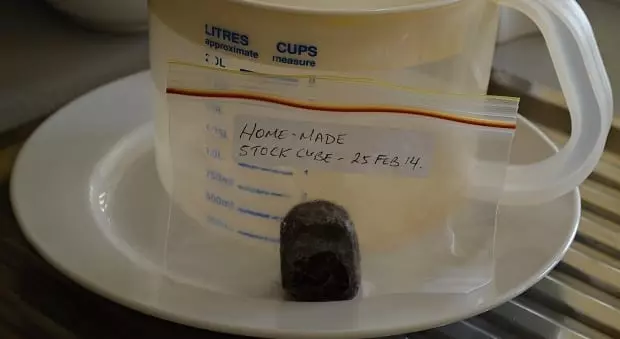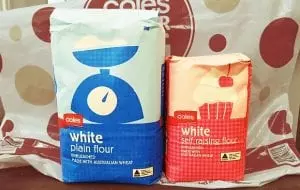All of us have probably bought stock cubes from the supermarket but did you know you can easily make your own stock cubes? This article is about how anyone can make a stock cube from their own left over cooking stock to be used later in making their next great tasting dish.
Sometimes when we cook we make more products than the food we actually serve and it’s possible many of us don’t even realise. I’m talking about stock (cooking stock) the base for many a dish giving great recipes and food amazing taste!

Home-made stock cube in a zip-lock bag (image above)
When we boil a silverside corned beef we don’t just have a great tasting sliced meat for dinner but we also now have a fully flavoured home-made beef stock which can be used for another meal such as soups, risottos, sauces, and many others.
The same goes for pretty much anything boiled and a great tasting stock can be made from chickens, ducks, fish, and of course vegetables – all of these products can produce an amazing stock which can subsequently be stored for a long period, if required, and used in that next masterful recipe.
The advantages of making your own stock cubes are:
- Saves space – Storing a frozen stock in a freezer bag or container takes up valuable freezer space whereas a stock cube is minimal and can be stored in a small container or snack zip-lock bag in the fridge.
- Saves money – Buying stock can be expensive.
- Saves waste – If you can make a second meal out of the first, such as, using the stock produced from a boiled meat rather than tipping it down the sink then that’s a great use of produce.
- Healthier – When you make your own stock you know what is in it. Unlike commercial stock which can have all sorts of preservatives and chemicals.
- Easier to use – If you just want a small amount of stock perhaps for an individual meal you can simply slice off a small amount of stock cube and use as necessary. Also, since the stock isn’t frozen it’s convenient and fast to make up.
What is needed to make a stock cube?
Liquid stock
Firstly, a good liquid stock is obviously required and this can be made by simply using the remaining liquid left over from a meal like a boiled chicken or silverside beef. Naturally, you can purposely make your own stock by incorporating any ingredients you like such as a nice vegetable and bacon stock made from celery, carrots, onions, and bacon pieces boiled and simmered down over a few hours.
The main point to highlight is whatever stock you make it should be simmered down and concentrated as much as possible rather than leaving too much liquid (the reason why will become apparent later in the method).
A little fat in the stock is fine but if you have a really fatty stock it’s best to remove the majority of fat before making the stock cube. An easy way to remove the majority of fat from a stock is to refrigerate it and let the fat solidify on top of the liquid so it can be easily scrapped off and removed.
Sieve
A fine sieve is required to strain the stock to ensure it’s relatively free from solids. The liquid stock doesn’t have to clarified or filtered (although you can if you want).
Non-stick shallow pan
For this method of making stock cubes to work the liquid needs to be dehydrated or dried on a non-stick surface and I’ve found one of the best containers to use for this is a shallow non-stick pan like a pizza tray (without holes). The reason the tray needs to be non-stick is so the dehydrated liquid can be scrapped off the base of the tray without too much effort.
Food dehydrator (or oven)
A food dehydrator is the best way to make a stock cube but you can still use an oven at a low temperature. In the main a food dehydrator uses less power than an oven and they are better designed for making stock cubes or dehydrating in general than an oven.
Method
Step 1 – Straining the stock
Strain the simmered down stock through a sieve or as suggested earlier you could refrigerate first and skim off the excess fat or clarify the stock using chef techniques or strain it through muslin. Personally, unless it’s really fatty I usually just strain my stock through a sieve to remove the solids.
Step 2 – Dehydrating the stock
Pour the strained stock onto a shallow non-stick tray like a pizza tray and place it into a dehydrator at about 68 °C or an oven on very low heat with the door slightly ajar. The dehydration process will take about 8 hours and you can tell when it is ready when the stock has formed a solid crust which doesn’t break too easily or come off when rubbed with a finger but is still moist underneath.
Step 3 – Scraping the dehydrated stock off the pan
Use a wooden or plastic stirring implement (or something similar) to scrap the stock off the pan and then mould it together into a cube.
Step 4 – Storage and use
Place the stock cube/s into a container or plastic zip-lock bag and store it in the fridge. For use, the cube can be cut into smaller pieces for single meals (like a single serve of noodles) or dissolved whole in an appropriate amount of hot water for a larger family meal. Stock cubes should last several months (or even more) in the fridge.

Home-made stock cube stored in the fridge (image above)
Notes & Links
Powdered stock – You could dry the stock until all the moisture is completely removed (this could only be done with a non-fatty stock) and then the dry stock flakes can be crushed into a powdered stock. Be aware it might be a good idea to use wax paper or a commercial dehydrator sheet on the bottom of the tray for easy removal of the dried stock because if completely dehydrated onto a pan base it could be hard to get off.
Dehydrators – If you don’t have a dehydrator I recommend the square/rectangle type units rather than the round because the square units with the fan at the rear dehydrate more evenly (but that’s up to you). You can purchase food dehydrators online:
How to make a stock cube video (only goes for 2 minutes)
Conclusion
Stock is such an important part of so many recipes and some of the most famous dishes world-wide would not be famous if it wasn’t for the addition of the humble stock. Making or saving a stock from great ingredients is one thing but storing it and reusing it is another story. With the home-made stock cube method of keeping stock it takes up less space for storage, lasts a long time in the fridge, and is easy to use as needed.
Mark Valencia – Editor SSM
Look, and see the Earth through her eyes…













